Pacific Coast Models | 32008: Focke Wulf Ta 152H-1
Reviewed by Randy Bumgardner

For the modeler who has a penchant for the Luftwaffe, the Ta 152H can certainly be considered one of the highlights of their modeling collection. Born out of a need to meet the changing wartime circumstances, the Ta 152 family, based on the highly successful Fw 190 series, was designed to incorporate increased armaments, different power plants, and various other modifications. Lead by chief designer Kurt Tank, who had the distinction of having the Ta 152 designation named after him, the Ta 152 series evolved into a group of aircraft that could meet the needs of the Luftwaffe:
- the Ta 152A and Ta 152B fighters
- the Ta 152C fighter-bomber
- the Ta 152H, high-altitude fighter
So, what models representing this aircraft are out there? In large scale, the only offerings up to this point are Jerry Rutman's resin kit and a few vacuformed kits. In the world of large scale injection molding, there is nothing, nada, zip for large scale subjects. Well, Pacific Coast Models has put an end to that. They have recently released their Focke Wulf Ta 152H-1 in glorious polystyrene, together with some resin and photo-etch bits.
The packaging of this kit is standard PCM fare – the familiar blue box, with some nice artwork on top, containing some injection molded parts trees, a resin cockpit and other resin details, a fret of photo-etch parts, and some very nice decals. Specifically, the kit contains 51 injection molded parts on 6 parts trees, of those, there are 2 clear parts on 1 parts tree. Also included are 24 resin parts, three of which are clear resin, a fret of 24 photo-etched parts, and a set of decals, produced by Cartograph, containing options for 4 markings.
The decals are up to the usual Cartograph standards. The registration is great and the decals are thin with minimal carrier film. The colors are pretty good, with the exception of the colors for the aircraft number. The green is too dark on the original sheet, so PCM also included a small sheet of corrected numbers in the proper color. The painting and decal guide is the standard PCM color guide that is supplied with all of their kits. It is easily readable and clearly marked. It does contains a few errors, though. A few of the color call outs are incorrect and the Gruppe symbol is missing. PCM provides a markings errata sheet to address the errors on the original markings guide.
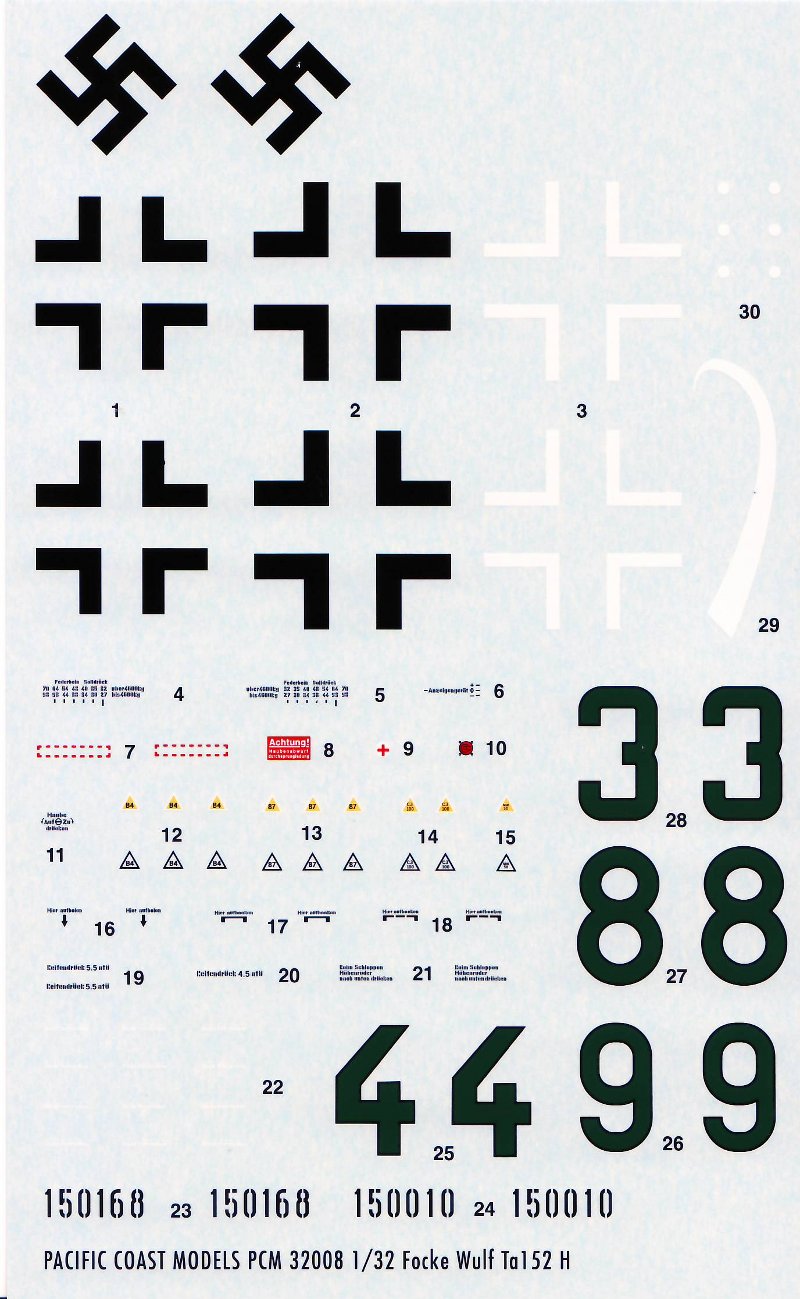
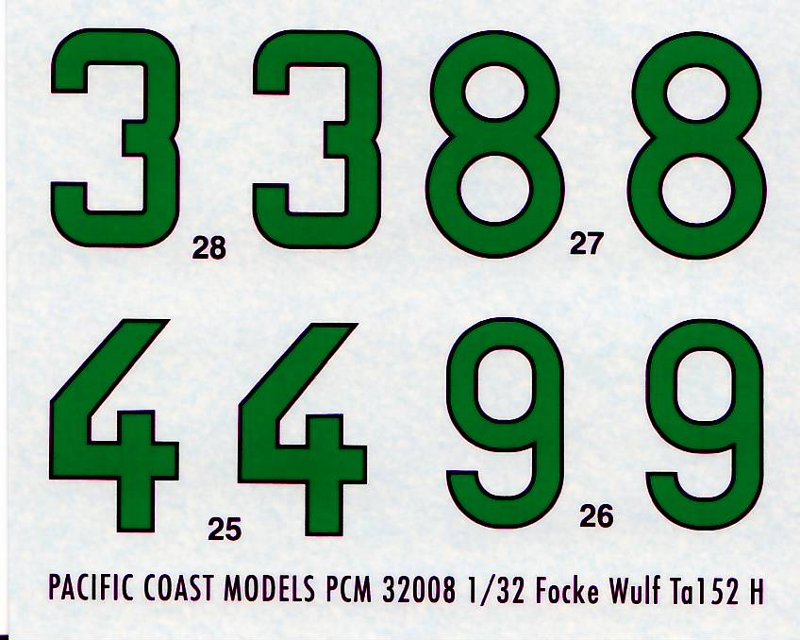
Even with the corrections, the colors indicated are suspect – well, at least one of the colors is suspect. Information and documentation on late-war Luftwaffe camouflage is relatively hard to pin down. Several historians and researchers have perform highly commendable work in this area to provide us with solid foundation to build upon. PCM mentions the use of RLM 83 in their painting guide. However, all of the references I have found indicate that the colors intended for the Ta 152 series were Farbton 81 and 82 on the upper-surfaces in the standard splinter camouflage scheme and Farbton 76 under-surfaces. Even this scheme, while entirely probable, isn't the initial scheme set forth by Focke Wulf.
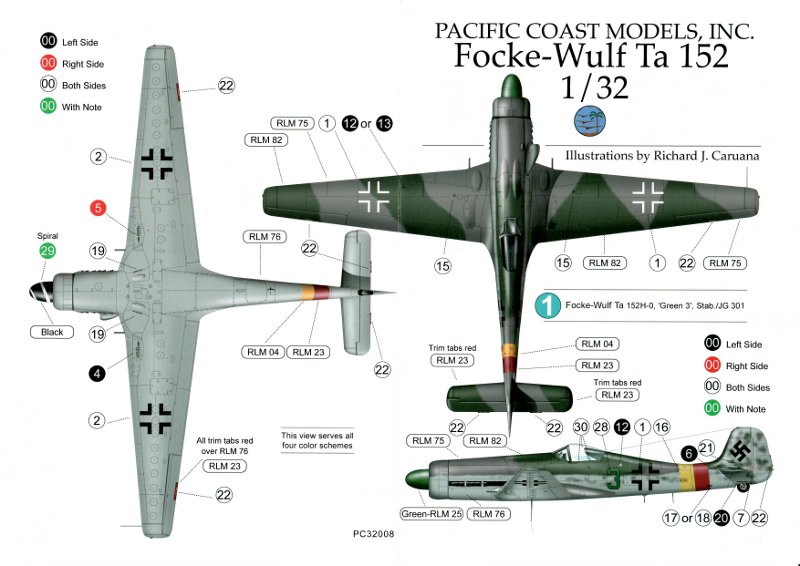
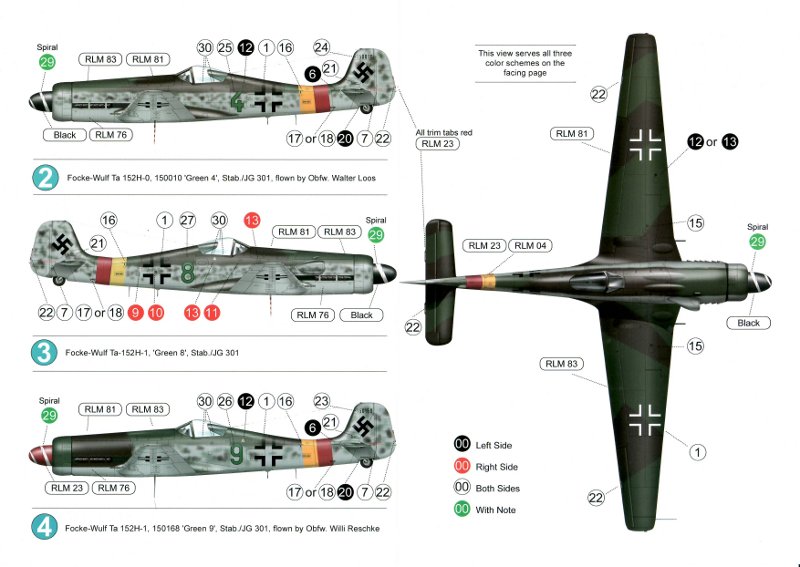
In March of 1944, Focke Wulf promulgated a drawing specifying the colors for use on the Ta 152 series. Drawing No. 8-152.000-4500 indicated the use of Farbton 74 and 75 in a splinter pattern on the upper surfaces, Farbton 76 on the side and under surfaces. This drawing was then amended on 1 November 1944, substituting Farbton 81 and 82 for 74 and 75, respectively. In addition, the revision also removed the specification of Farbton 76 on the under surfaces of the aircraft leaving them bare metal.
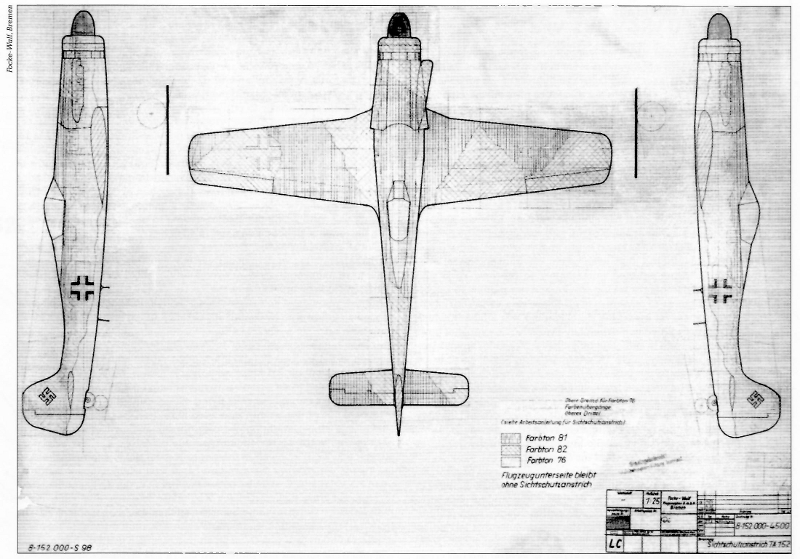
From "Focke-Wulf Ta 152: Ta 152A - Ta 153", Lowe, Malcolm V. Lowe 2008, 4+ Publications
Confused yet? The bottom line here is to check your references about the specific aircraft you wish to build, and then paint accordingly. Else, for options 2, 3, and 4, use RLM 82 where RLM 83 is specified. For option 1 – the Ta 152H-0, use RLM 83 instead of the RLM 82 that is specified. Michael Ullmann, in his book “Luftwaffe Colours, 1939-1945”, interprets a photograph of Ta 152H-0, WNr. 150003, as either 74/75/76 or 74/83/76. This is entirely possible as the first of the 20 pre-production Ta 152H-0s began delivery in October of 1944 – one month prior to the amended camouflage revision by Focke Wulf. So, based on Ullmann's interpretation, it is entirely possible that the first few Ta 152H-0 aircraft could have been painted 74/75/76. Of course, with all things Luftwaffe, there are exceptions – which, at times, seems to be the rule. Always check your references.

From "Luftwaffe Colours 1939-1945", Ullmann, Michael Lowe 2002, Hikoki Publications
The resin cockpit is a little gem with very nice details. The cockpit tub contains some great details on the sidewalls and the instrument panel detail is well represented. Add to it the photoetch details that are supplied in the kit, and you have a magnificent representation of a Focke Wulf 190A/D/Ta 152 series cockpit. What? Well, the cockpit as supplied in the kit contains side consoles from the Fw 190D and an instrument panel that contains sections from the Ta 152, the Fw 190D, and the Fw 190A. That being said, the cockpit can still be built as is, and it will turn into a great item providing much visual interest to the finished model. The discrepancies in the details are not necessarily something everyone is going to notice or even realize exist. Nobody is going to jump onto the table next to your model, grab a bullhorn, and start wailing the faults of your model.
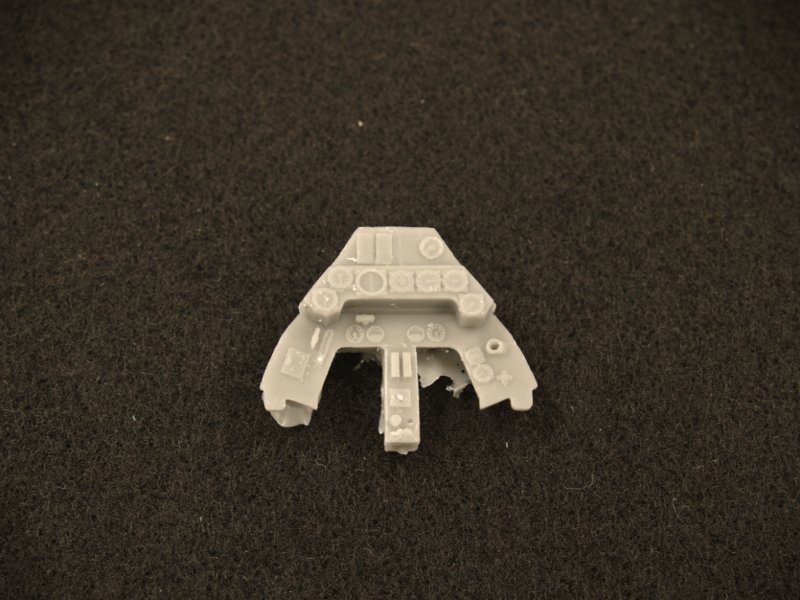
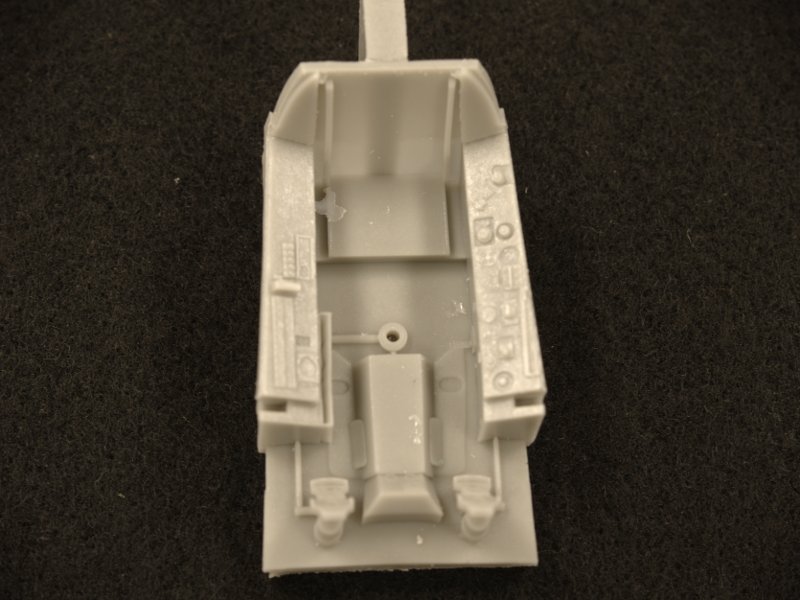

Focke-Wulf Ta 152H instrument panel.
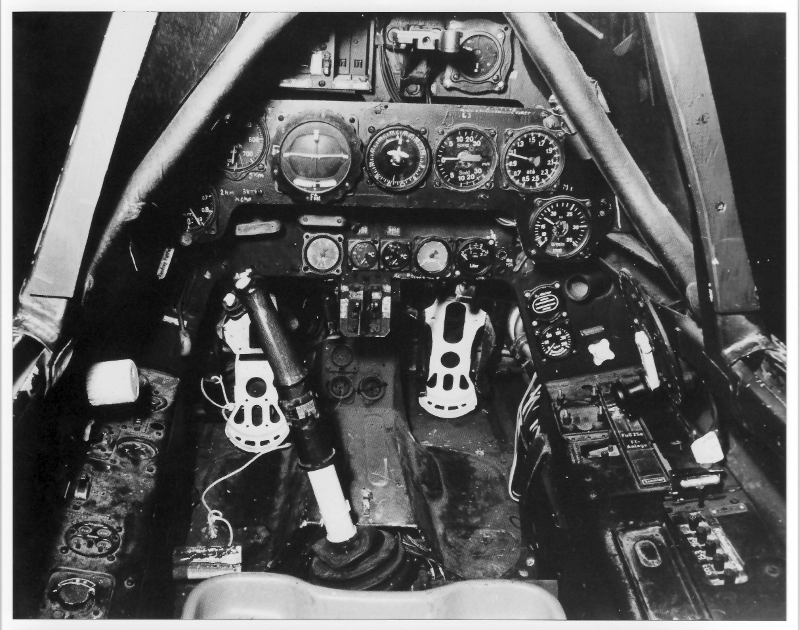
Focke-Wulf Fw 190D instrument panel.
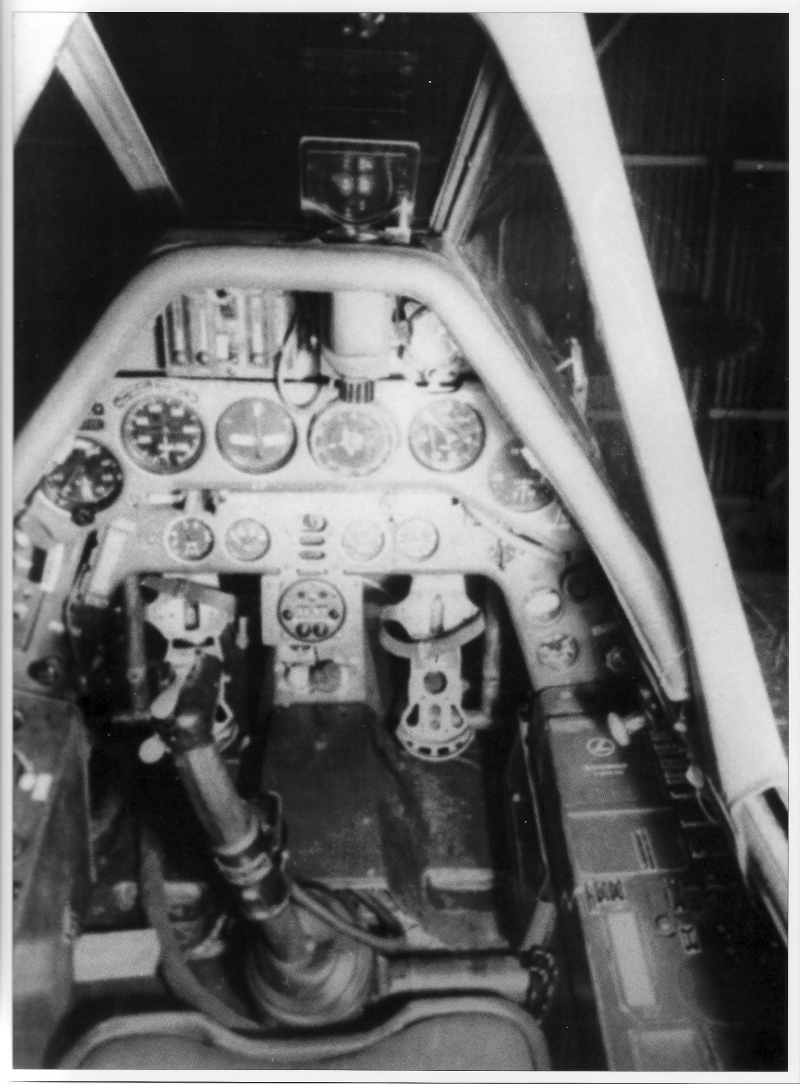
Focke-Wulf Fw 190A instrument panel.

Focke-Wulf Fw 190D port console.
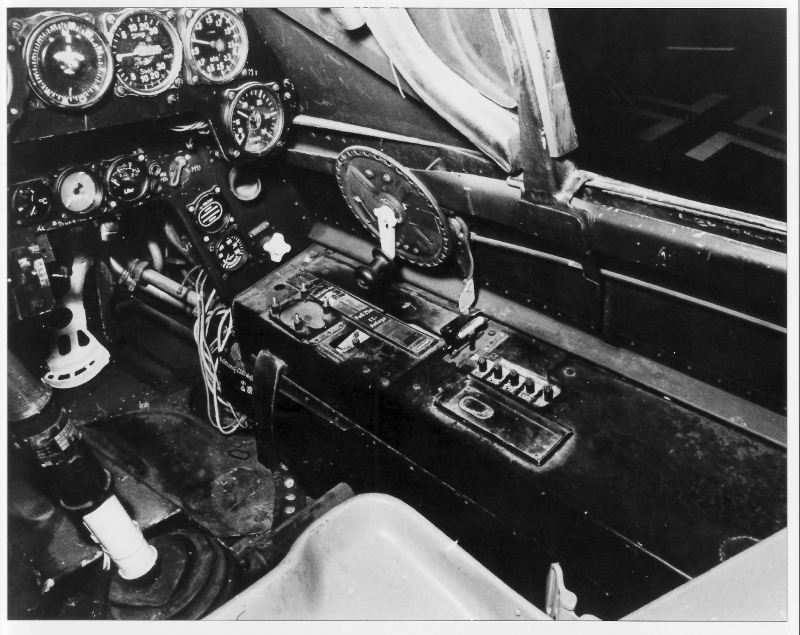
Focke-Wulf Fw 190D starboard console.
Images from "German Aircraft Interiors 1939-1945, Volume 1, Merrick, Kenneth A. 1996, Monogram Aviation Publications.
So, the other resin bits in the kit include a set of very nice looking exhausts. They are slightly hollowed at the end and, after a bit of weathering and staining, will look very nice on the completed model. Along with the exhausts, there is a set of resin wheel wells and a nicely detailed engine plug. The three pieces fit together well and, along with a main spar section, drop into the lower wing mid-section. There is only one problem, well two really – but we'll get to the other issue shortly, the engine plug is for the incorrect engine. The Ta 152H used the Jumo 213E inverted V-12 engine. The engine plug supplied in the kit represents the Daimler-Benz DB 605 engine. The DB 605 powered notable aircraft such as the Messerschmitt Me 109 and Me 110 along with Italian aircraft such as the Reggiane Re 2005, Macchi C.205, and Fiat G.55. As a matter of fact, the engine plug in the Ta 152 kit (right) looks exactly like the engine plug in the Fiat G.55 kit (left), as shown in the bottom image below. I talked with PCM about this issue and they were less than pleased. PCM is looking into this particular issue and hopefully a resolution will be reached.
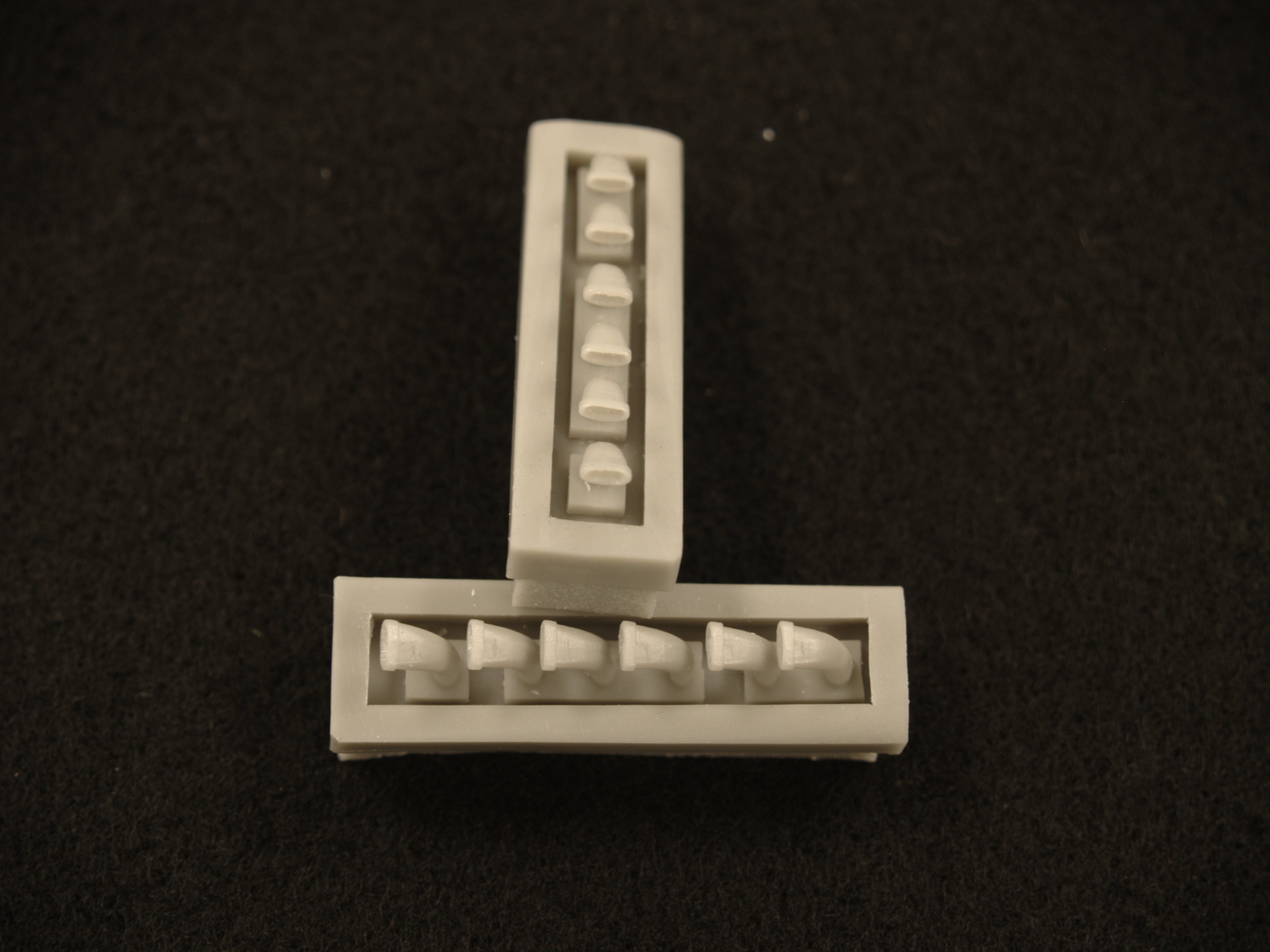
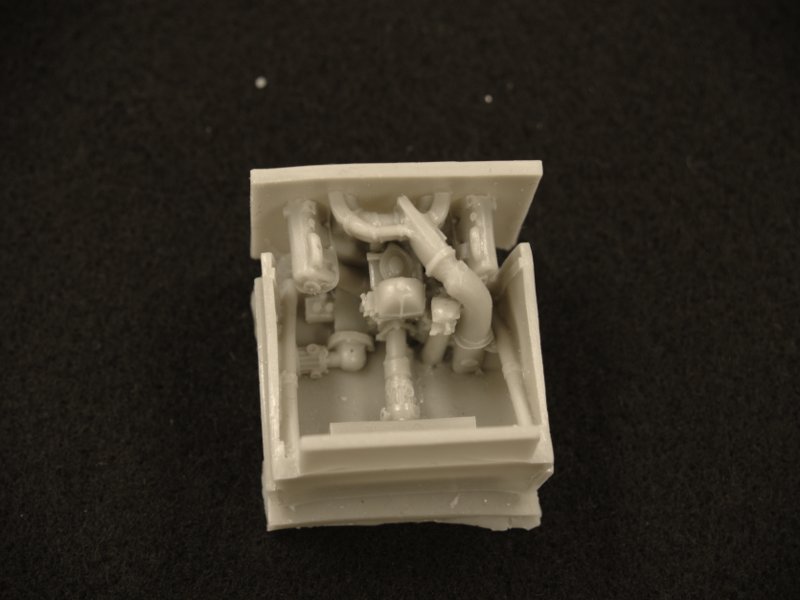
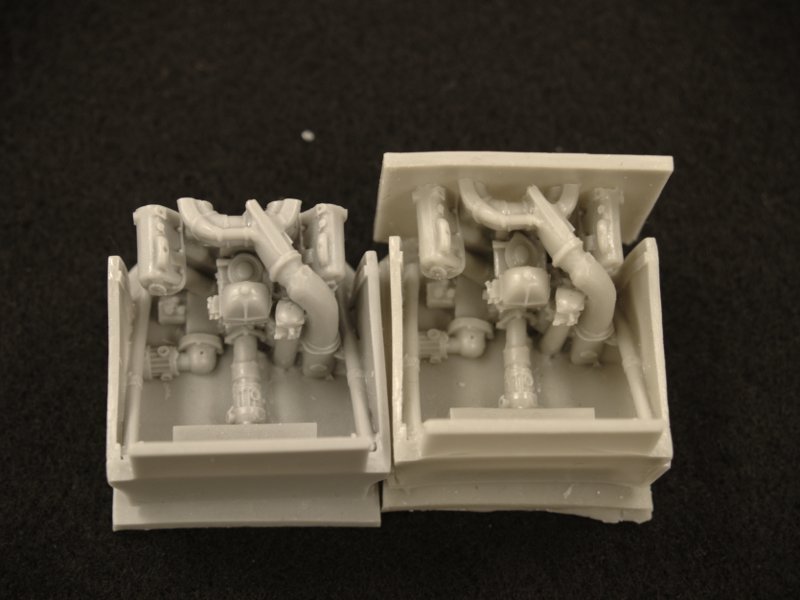
The wheel wells are molded very nicely. They contain no flash and the detail is pretty good. One caveat, though. If built out of the box, they are cast to use parts that represent the electric retraction mechanism that was present on the Focke Wulf Fw 190 series. Although based largely on the Fw 190 design, the retraction mechanism on the Ta 152 series was redesigned to use a hydraulic actuator, this included the flaps as well. The modeler has the choice of either scratchbuilding the hydraulic retraction arm or sourcing this part from somewhere else, e.g., another kit, the spares box, etc. The inner gear doors utilized a kickplate and spring mechanism for closure. As the main gear was retracting, the tire would contact the kickplate and the retracting wheel, aided by the spring, would close the inner gear door. The PCM kit does not include this detail on it's inner gear doors, so the modeler is left to scratchbuild this particular detail.


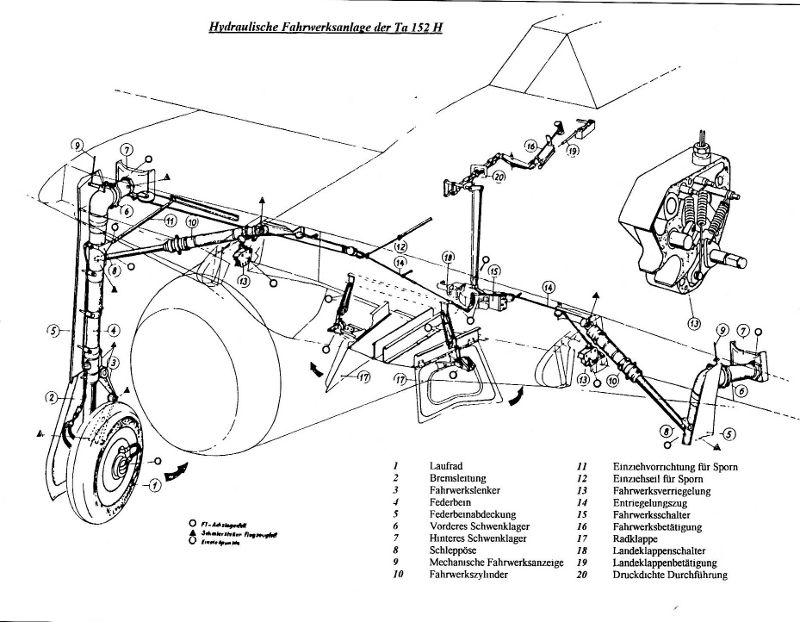
Image from "Focke-Wulf Ta 152, The Story of the Luftwaffe's Late-War, High Altitude Fighter", Harmann, Dietmar 1999, Schiffer Publishing, Ltd.
The injection molded parts are molded in soft grey plastic – fairly typical for limited run kits. There is very little flash present and no sink marks on any of the parts on my review sample. There are a few ejection pin marks. The are in the form of little stubs on the interior of the parts. Most do not seem to get in the way of assembly, however some will and the modeler should always test fit the assembly prior to gluing.
The panel lines are recessed and are a fairly constant depth for the most part. They do fade as they approach a seam, i.e., the upper and lower edges of the fuselage halves. So, the modeler will have to do some scribing. The placement of the panel lines, covers, and hatches is pretty good overall when checked against the drawings by Tom Seay and Radek Vavrina. The two sets of plans aren't entirely in agreement, although they are very close.
Some of the detail is a bit soft, such as the radiator louvers on the top of the cowl. This can be attributed to the injection molding process used rather than the design of the kit. An obvious error is the conspicuous lack of shell ejection ports on the underside of the fuselage. The Ta 152H carried a pair of MG 151/20 20mm cannons in the wing roots and an engine-mounted MK 108 30mm cannon. The shell ejection ports for this armament are quite visible on the underside of the aircraft. Thus, the modeler will have to drill out their own.
In general, the overall shape of the aircraft is pretty good. I mean, any modeler who is going to build it straight out of the box will get a nice model of the Ta 152H in return. If, however, the modeler is concerned with accuracy, especially regarding the specific shape of the airframe, then things will look a little “off” the more they examine it. For instance, the propeller blades supplied in the kit do not resemble the VDM VS9 propeller blades on the actual aircraft. The modeler can reshape them, or find some aftermarket prop blades. The cowl flaps are another oversight in the kit. The Ta 152 did not have the same cowl flaps as the Fw 190D which were uniform in size and shape. The cowl flaps on the Ta 152 were were dissimilar in that every other flap was smaller and shaped like a trapezoid with the alternate cowl flaps shaped like rectangles. This is shown in the image below of the Ta 152H forward fuselage section at the National Air and Space Museum.
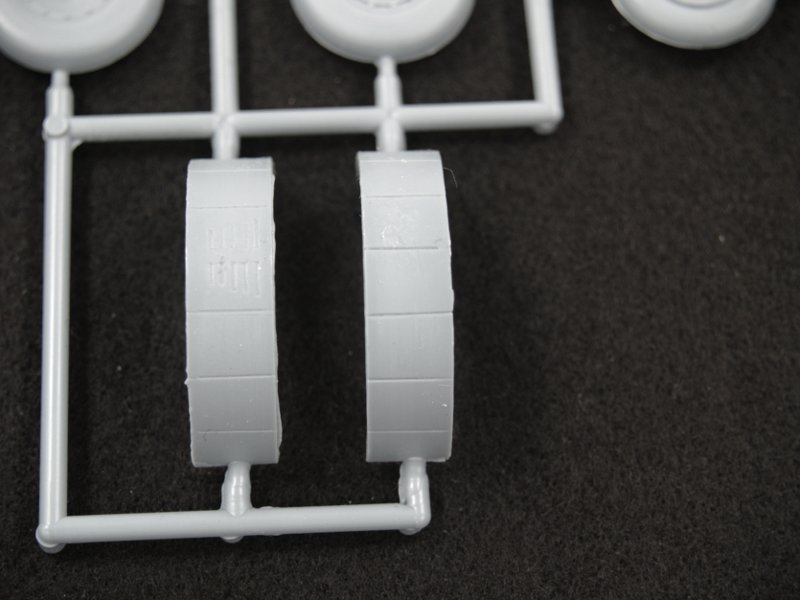
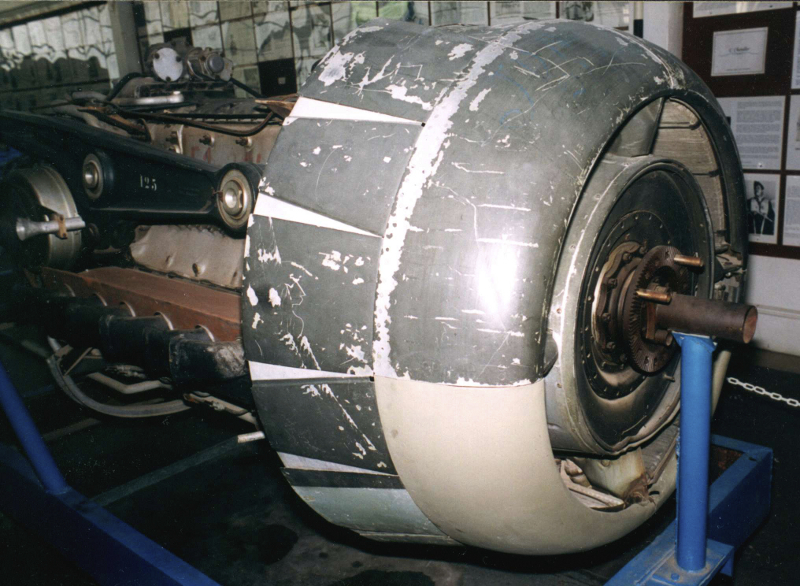
In addition, the cowling blisters immediately forward of the exhaust ports should not be present. They were in place on the Fw 190D, but the Ta 152 did not have them, as shown in the photo below of the NASM Ta 152H forward fuselage.
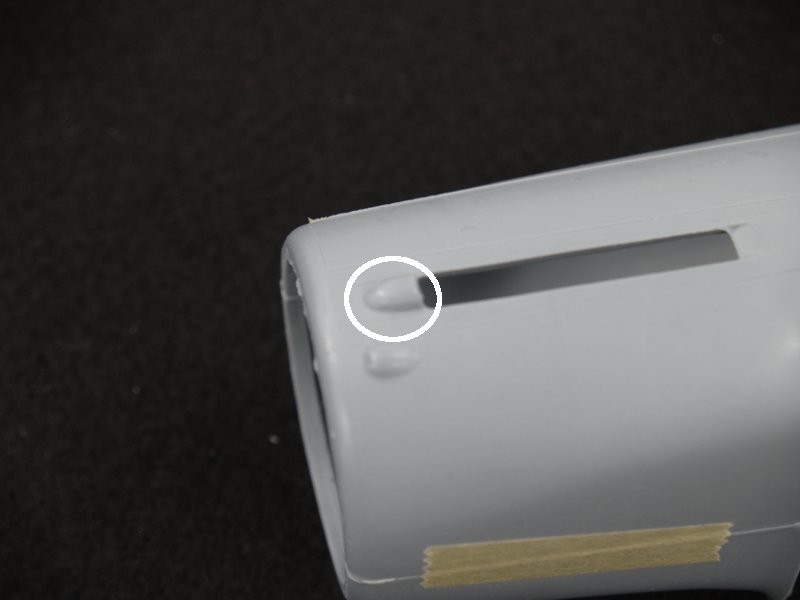
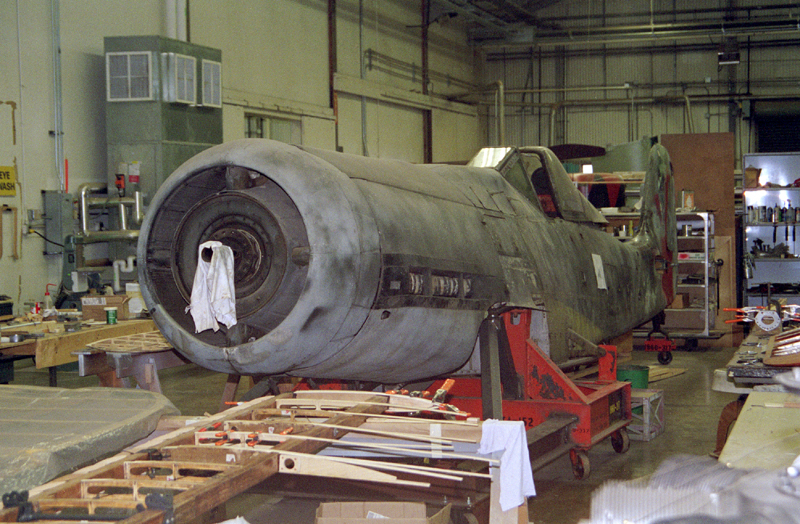
Image from the internet - credit goes to the original photographer.
One area to be ready for is the three piece lower wing. To solve the packaging issue of the very long wingspan of this aircraft, PCM decided to use a lower wing center section and a pair of outer lower wing sections. Be very careful aligning these parts as you are assembling the wing structure. I recommend joining, aligning, and gluing the three lower wing sections first. Be sure to use an extra piece of styrene at the joint on the inner surface to give the joint additional strength.
A unique feature of the Ta 152 is the "kink" in the trailing edge at the aileron/flap junction, shown in the image below. It's not really a kink, but a slight change in the dihedral of the trailing edge. The wing was designed with a 2.5 to 3 degree negative twist from the wing root trailing edge to the flap/aileron junction. The dihedral of the leading edge remained constant throughout it's length. This provided a slight twist in the wing that delayed the separation of airflow around the outer section of the wings – giving the aileron more control at higher angles of attack at higher altitudes. This subtle twist gives the wing an inverted gull shape when viewed from behind. This is evident in images taken of the rear of the aircraft looking forward. I'm not sure how the modeler could attempt a fix for this, it isn't an error that is easily remedied.

From "Luftwaffe Colours 1939-1945", Ullmann, Michael Lowe 2002, Hikoki Publications
In summary, I want to strongly reiterate that this kit will build up as a very nice, reasonable representation of the Ta 152H-1. Anyone wishing to build it straight out of the box will be rewarded with a nice model of the Ta 152H. The devil is in the details, and there are some obvious errors, such as:
- the incorrect engine plug (DB 605 instead of the Jumo 213);
- the incorrect cowl flaps;
- the conspicuous lack of shell ejection ports for the cannon;
- the incorrect retraction arms for the main landing gear (the Ta 152 used hydraulics and the previous versions in the Fw 190s all used electric drive);
- the extra thickness at the base of the vertical tail.
These are errors that can be fixed with some work - with the exception of the engine plug. Pacific Coast Models is working on that issue and, in the meantime, the engine plug can be gotten from external sources (Jerry Rutman, for example) or scratchbuilt.
There are also some not so evident errors, which can also be fixed, that may not be readily known by someone with only a passing knowledge of the Ta 152:
- the instrument panel is more appropriate for a Fw 190A rather than a Ta 152, and the cockpit side consoles are closer to the Fw 190D;
- the horizontal stabilizers are a bit too thick, as is the wing root - however, this can be attributed to the idiosyncrasies of limited run injection molding rather that a gaff on the part of the manufacturer;
- the panel lines on the empennage should not be present as some sources state that the Ta 152H-1 used the wooden tail. Here again, other sources disagree and there isn't much conclusive proof;
- the wing tips are incorrectly shaped around the navigation light area;
- the shape of the front end, both the upper and lower cowlings are subtly off - not very noticeable, but enough so that is "just doesn't look right" when viewed at certain angles;
- the cross-section of the rear fuselage is "too flat" on top. This leads to the overly-thick vertical tail mentioned earlier.
Again, I would categorize these types of errors as minor, and the modeler could tackle them if they wanted.
So, in a nutshell, that is the bottom line on the Pacific Coast Models Focke Wulf Ta 152H-1. There are other little niggles here and there, but the above issues are the big ones that stick out. Don't get me wrong - I like this kit, and I think it's a great thing that Pacific Coast Models took the bull by the horns and brought this kit to market. I also think that some basic research was not done completely and that introduced errors in the final product. It's up to each modeler to know where they stand with regard to their skill level and how much work they want to put into the kit.
The review sample is courtesy of Design & Marketing Int'l, “Thanks Patrick!”
Gratuitous Sprue Shots
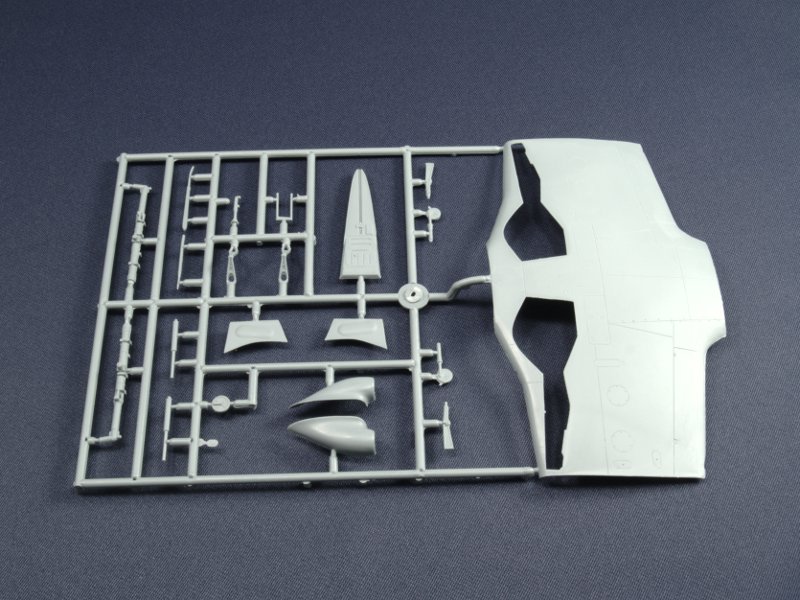
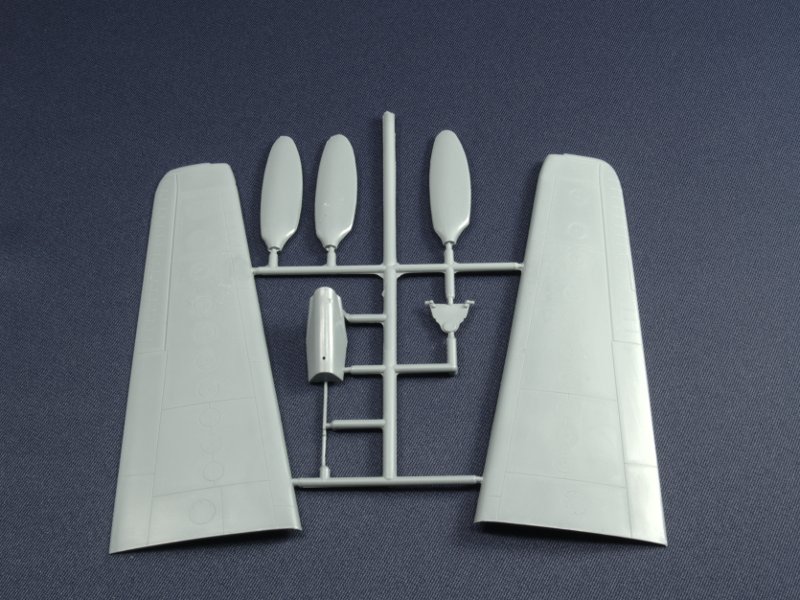
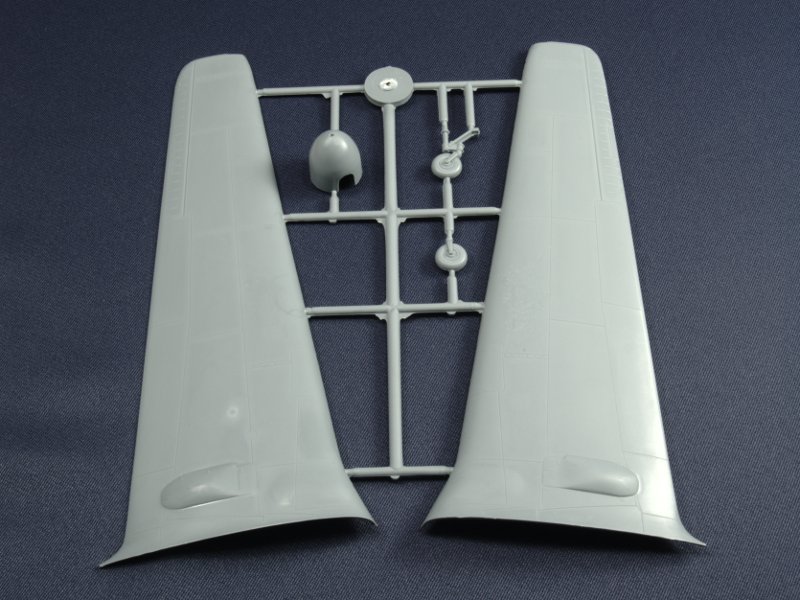
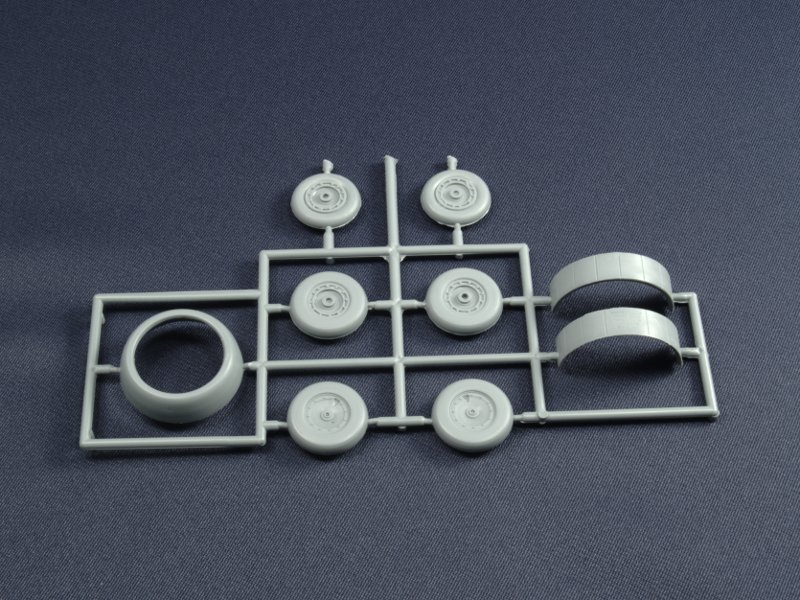
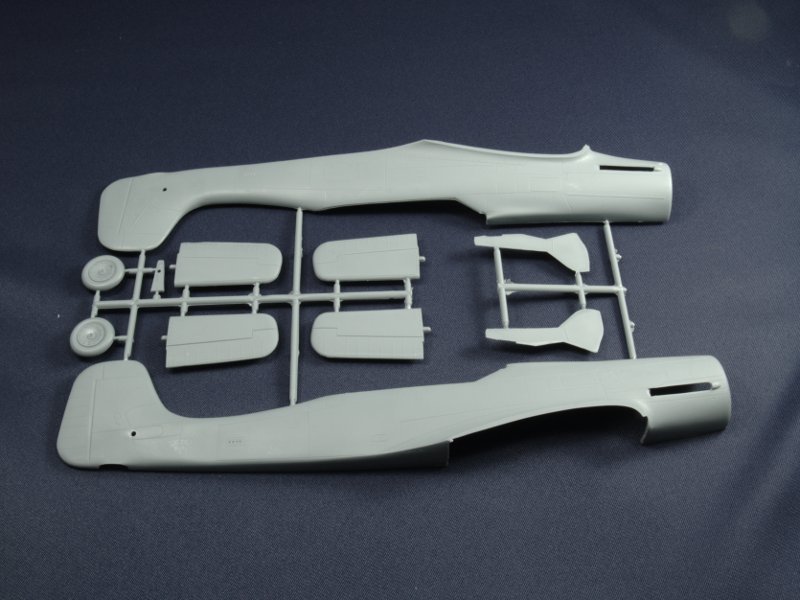
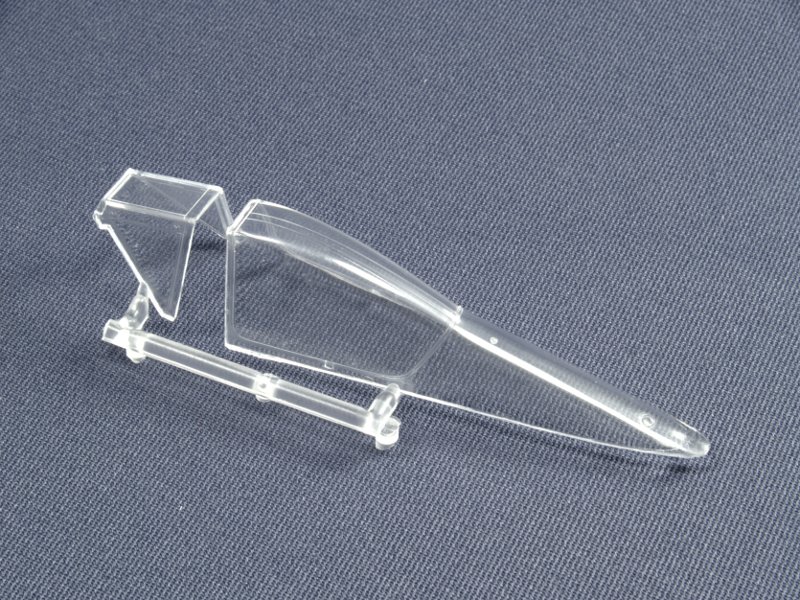
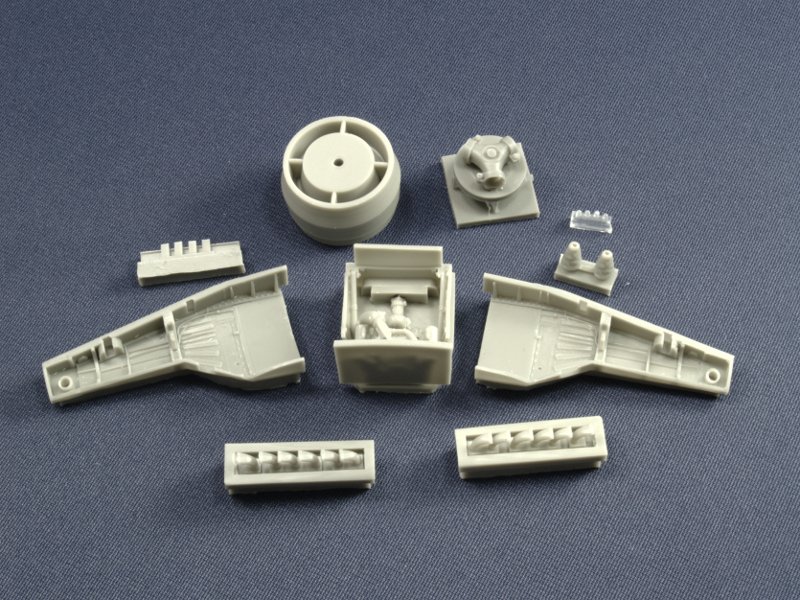
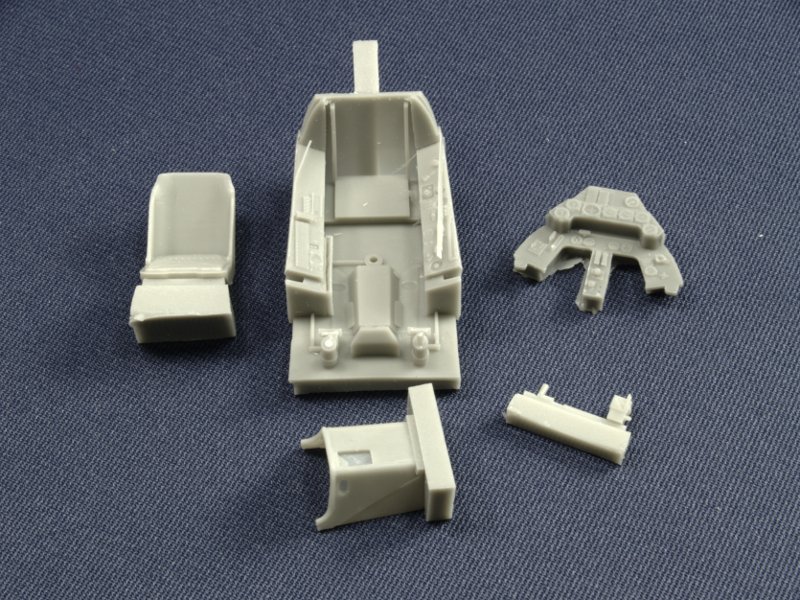
References
- Harmann, Dietmar. Focke Wulf Ta 152, The Story of the Luftwaffe's Late Variant High-Altitude Fighter. Atglen: Schiffer Publishing, Ltd., 1999.
- Lowe, Malcolm V. Focke Wulf Ta 152: Ta 152A, Ta 152B, Ta 152C, Ta 152E, Ta 152H, Ta 153, 4+ Publications Special Edition. Czech Republic: Mark I Ltd., 2008.
- Vavrina, Radek. Focke Wulf Fw 190V1 to Ta 153, Detail Drawings. Czech Republic: R.V. Resin, 2006.
- Vavrina, Radek. Special Drawings: Focke Wulf Fw 190C/Fw 190D/Ta 152 part II. Czech Republic: CMK Kits, 2007.
- Merrick, Kenneth A. German Aircraft Interiors 1935 – 1945, Volume 1. Sturbridge: Monogram Aviation Publications, 1996.
- Merrick, K. A. German Aircraft Markings 1939-1945. New York: Sky Books Press Ltd., 1977.
- Merrick, K. A. and Kiroff, Jurgen. Luftwaffe Camouflage and Markings 1933-1945, Volume One. Hersham: Classic Publications/Ian Allan Publishing, 2004.
- Merrick, K. A. and Kiroff, Jurgen. Luftwaffe Camouflage and Markings 1933-1945, Volume Two. Hersham: Classic Publications/Ian Allan Publishing, 2005.
- Ta 152H-1. 1/24th scale three-view drawings. T. V. Seay, 1975. Reproduced by Eagle Editions Limited, 1997.
© Randy Bumgardner 2009
This review was published on Saturday, July 02 2011; Last modified on Wednesday, May 18 2016

